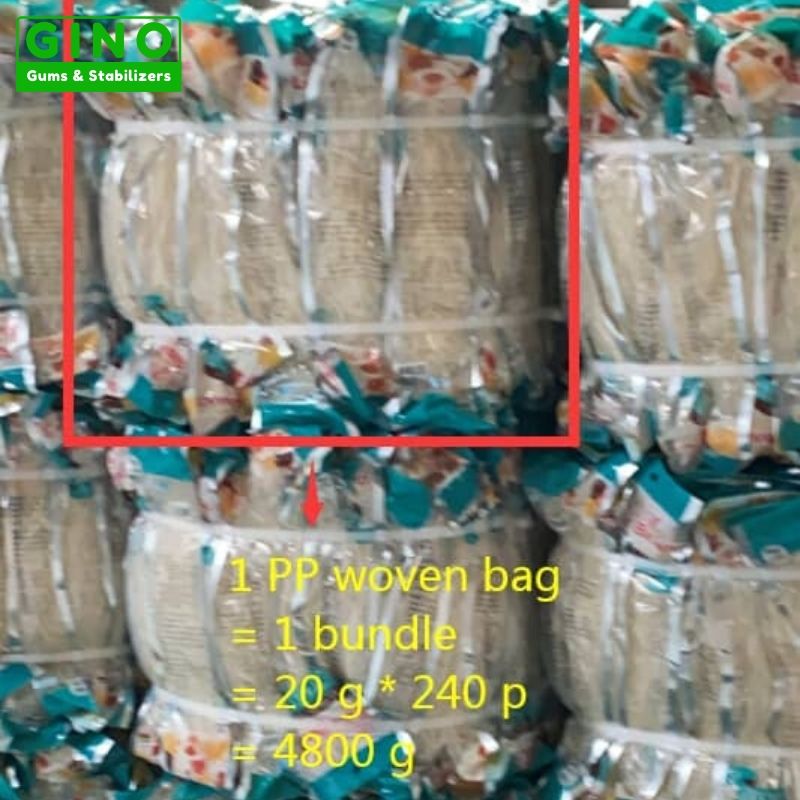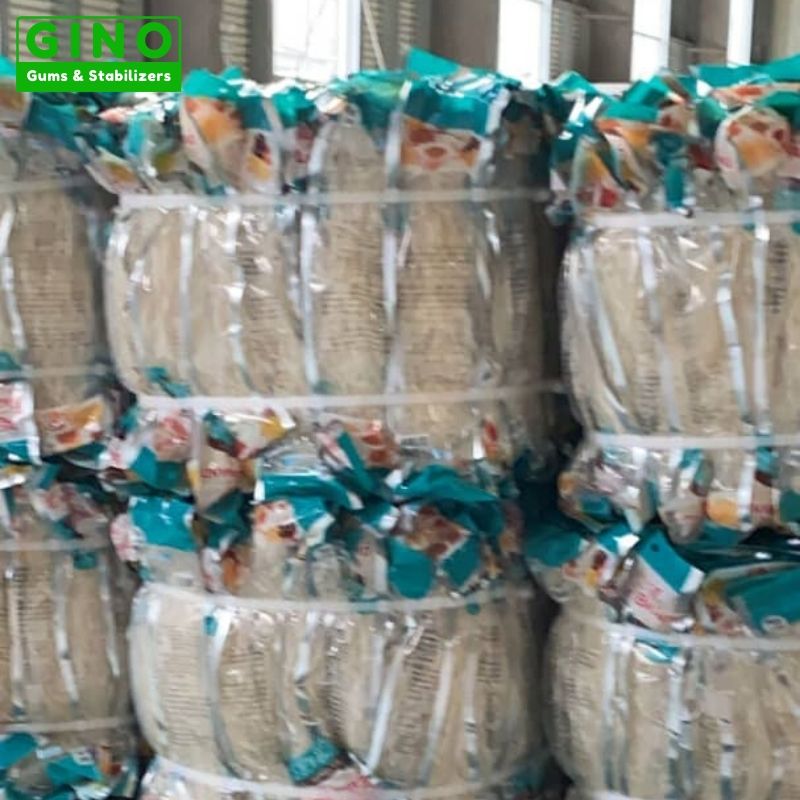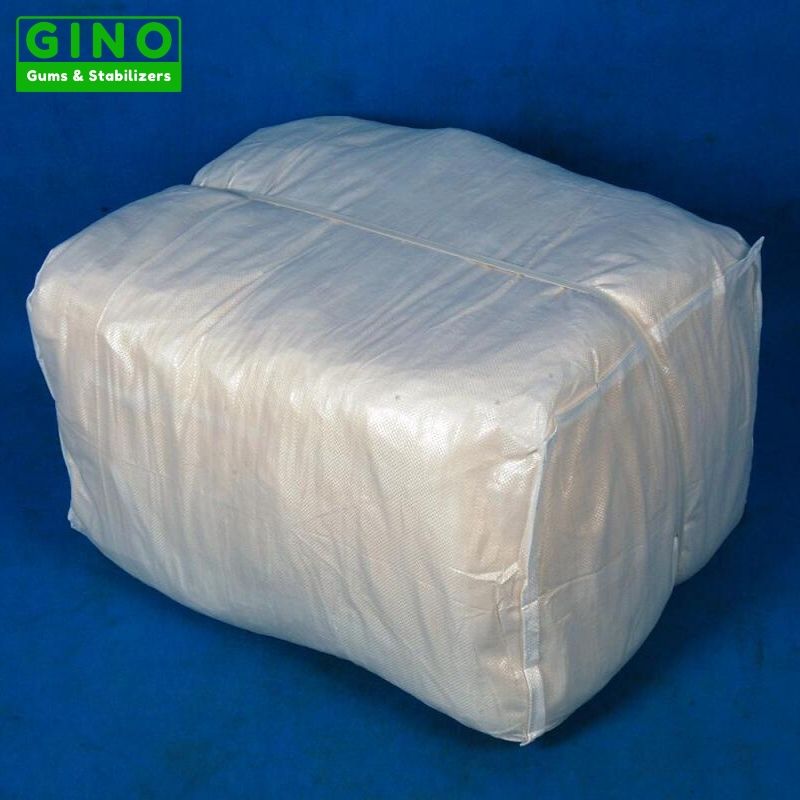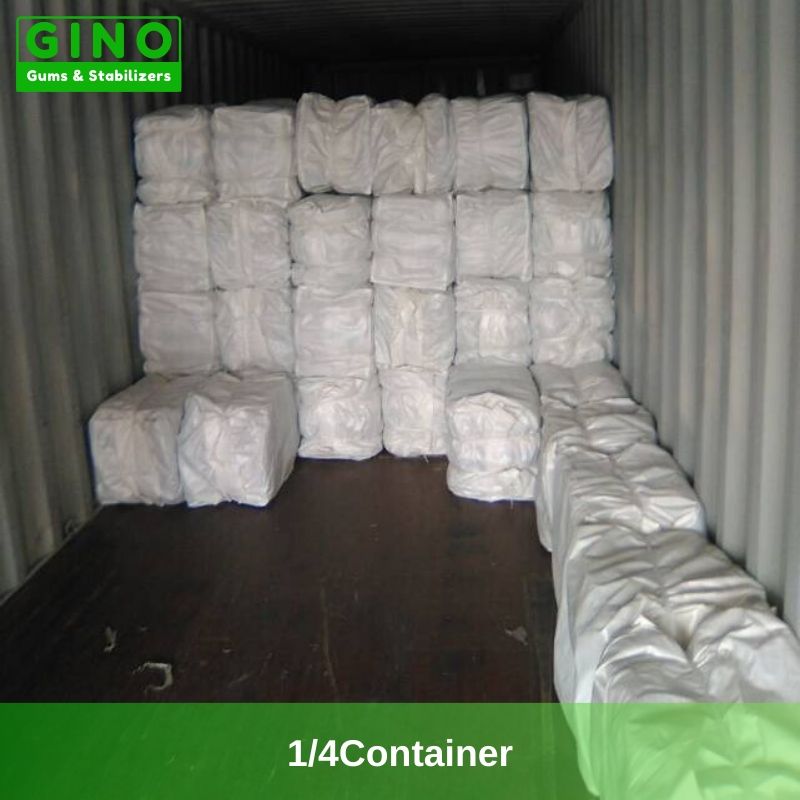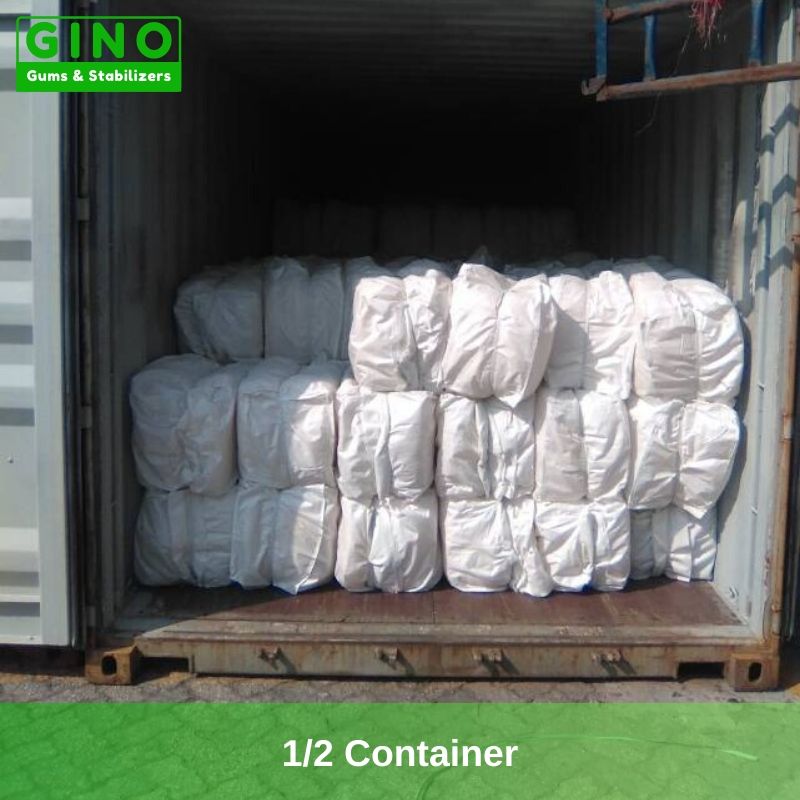Paski agarowe
Co to jest Agar Agar
Agar Agar jest hydrokoloidem lub fitokoloidem z wodorostów, o długiej historii stosowania jako żelujący, zagęszczający i stabilizujący dodatek do żywności. Uważany jest za najsilniejszą naturalną gumę hydrokoloidową, a także doskonały substytut żelatyny pochodzenia zwierzęcego.
Jako jeden z profesjonalnych producentów, dostawców i eksporterów agaru agarowego w Chinach, firma Gino jest zaangażowana w dostarczanie najwyższej jakości produktów od wiarygodnych producentów agaru agarowego. Dzięki naszej różnorodności systemów żelujących/stabilizujących możemy tworzyć rozwiązania dostosowane do indywidualnych potrzeb, idealnie dopasowane do wszystkich Twoich potrzeb.
Skontaktuj się z nami, aby zapytać o pojedynczą gumę hydrokoloidową lub stabilizatory żywności (mieszanki i systemy), które będą odpowiednie dla Twoich produktów. W przypadku jakichkolwiek pytań prosimy o przesłanie wiadomości e-mail na adres [email protected].
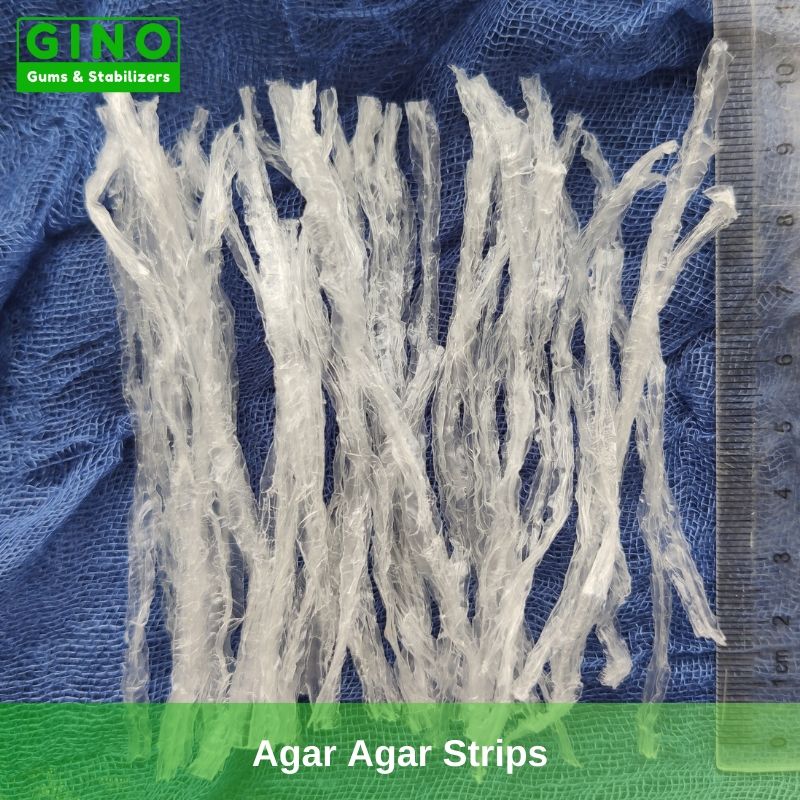

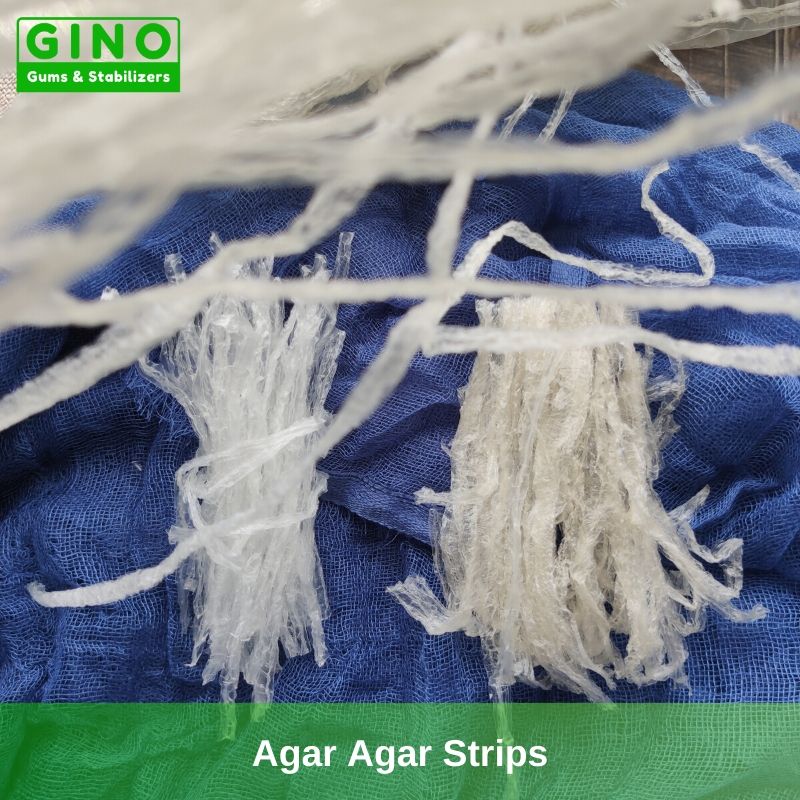

Paski agarowe
| Kategoria | Zagęszczacze, stabilizatory |
|---|---|
| Numer E | E406 |
| Nr CAS. | 9000-70-8 |
| Kodeks H.S. | 1302310000 |
| Pochodzenie | Chiny |
| MOQ | 500 KG |
| Opakowanie | Kartony, torby, beczki |
| Termin płatności | T/T, L/C |
GINO_Twoi najlepsi producenci agaru agarowego
Z czego składa się Agar Agar?
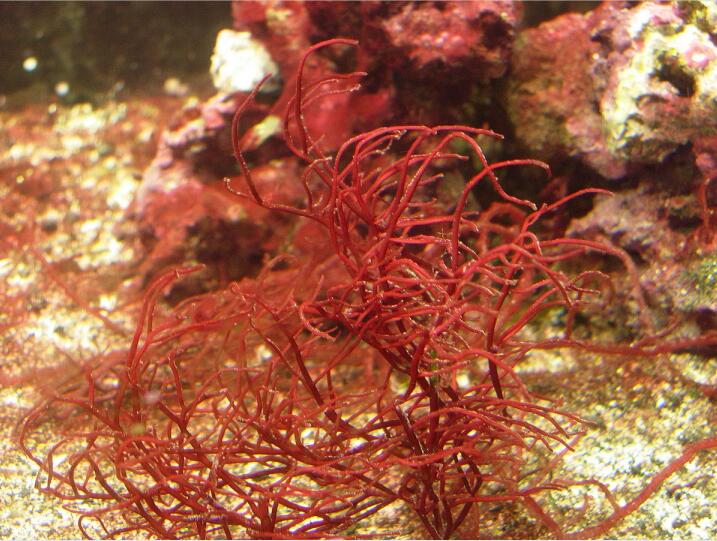
- Surowce
Skąd pozyskuje się agar agar?
Jest to rodzina liniowych polisacharydów galaktanowych otrzymywanych ze ścian komórkowych czerwonych wodorostów, Gelidium i Gracilaria są głównymi gatunkami wykorzystywanymi do komercyjnej produkcji agaru.
Gatunki Gelidium były pierwotnymi materiałami używanymi w Japonii, ale niedobory podczas II wojny światowej doprowadziły do odkrycia, że gatunki Gracilaria są odpowiednie, jeśli wodorosty zostaną poddane obróbce alkalicznej podczas przetwarzania.
Schemat przepływu produkcji
Paski agarowe
Gracilaria (lub Geldium) → Ługowanie alkaliczne → Mycie → Bielenie → Gotowanie żelu → Filtrowanie → Pchanie pasków → Zamrażanie → Odwadnianie → Suszenie → Gotowy produkt → Pakowanie.
Nasz asortyment produktów
Będziesz cieszyć się wszystkimi gatunkami i formami produktów agarowych, w tym:
Arkusz specyfikacji
| Charakterystyka sensoryczna | |
| Wygląd | Ma postać pasków o lekko białawym kolorze, neutralnym zapachu i smaku. |
| Charakterystyka chemiczna i fizyczna | |
| Wilgotność | ≤12% |
| Popiół ogółem | ≤5% |
| Wytrzymałość żelu (metoda Nikkan) | 500-700 g/cm2 |
| Ph | 5-7 |
| Skrobia Dekstryna | Niewykrywalny |
| Żelatyna i inne białka | Niewykrywalny |
| Substancje nierozpuszczalne w wodzie | ≤15% |
| Heavy Metal | ≤1 Ppm |
| Popiół nierozpuszczalny w kwasie | ≤0,5 % |
| Charakterystyka mikrobiologiczna | |
| Całkowita liczba płytek | Maks. 5000 CFU/g |
| Drożdże i pleśnie | Maksymalnie 300 CFU/g |
| E.Coli | Nieobecny w 5g |
| Salmonella | Nieobecny w 5g |
Uwagi:
Arkusz specyfikacji służy wyłącznie jako wskazówka i odniesienie. Wyniki klienta mogą się różnić ze względu na różnice w warunkach testowania, sprzęcie i metodach.
Nasze opakowania
Jako jeden z profesjonalnych i odpowiedzialnych producentów agaru agarowego, oprócz dostarczania wysokiej jakości produktów, staramy się również oferować elastyczne rozwiązania opakowaniowe, aby zapewnić niestandardowe opakowania, a nasz cel jest prosty, po prostu:
- Rozbudowa twój marka sens i rozwijać się prywatny marka
- Promowanie wizerunku własnej marki.
- Wzmocnij swoje promocyjne działania marketingowe.
- Wyróżnij się na tle konkurencji.
10 g Neutralny 20 g Red Ribbon 10-1000 g Private Label 10 kg Neutralny
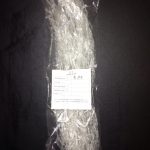

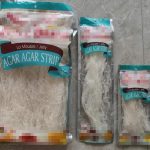
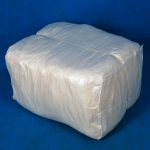
Loading & Delivery & Shipping
Będziesz zadowolony:
Różne style pakowania, elastyczne metody załadunku, mała ilość zamówienia, szybki czas dostawy ...
| Ilość załadunku | |||
| Opakowanie | Pojemnik | Ilość | Waga netto |
| Tkana torba 10 kg Pp | 1*20' FCL | 250 worków | 2,500 kg |
| 10 g Plastikowa torba | 250 worków= 250 wiązek * | 1,200 kg | |
| Torba plastikowa 20 g | 250 worków= 250 wiązek * | 1,200 kg | |
| Czas dostawy | |||
| Opakowanie zbiorcze 10 kg | W ciągu 2-3 tygodni od dokonania przedpłaty | ||
| Małe opakowania detaliczne | W ciągu 4-6 tygodni od dokonania przedpłaty | ||
Uwagi:
- Jeśli worek plastikowy 10 g, 1 wiązka = 10 g * (400-500)=4,0-5,0 kg;
- Jeśli plastikowa torba 20 g, 1 pakiet =20 g * (200-250)=4,0-5,0 kg.
- Od projektowania opakowań, wyboru materiałów opakowaniowych i drukowania opakowań po pakowanie ręczne, dostawę, wszystko w jednej usłudze.
Wybieramy tylko renomowane linie żeglugowe, aby zapewnić bezpieczeństwo i czas. Od naszego magazynu do portu docelowego, a nawet do Twojego magazynu, "Full Tracking Service" jest zawsze z Tobą.
Agar Agar Właściwość
Najważniejsze cechy agaru agarowego są następujące.
Duża moc żelowania
Jego duża zdolność żelowania w środowisku wodnym pozwala mu tworzyć żele, które są bardziej odporne (silniejsze) niż te z jakiegokolwiek innego środka żelującego, przy założeniu użycia takich samych stężeń.
Nie są potrzebne żadne odczynniki
Prosty roztwór wodny ma taką moc żelowania. Nie ma potrzeby dodawania odczynników w celu wytworzenia żelowania, takich jak potas (lub białka, co jest konieczne w przypadku karagenów), wapń (lub inne kationy dwuwartościowe, co jest konieczne w przypadku alginianów). Wysokie stężenie cukru lub kwaśne środowisko (co jest konieczne w przypadku pektyn) nie są potrzebne.
Szeroki zakres pH
Może być stosowany w szerokim zakresie pH, od 5 do 8, a w niektórych przypadkach poza tymi granicami. Bardzo dobrze znosi obróbkę termiczną, nawet powyżej 100°C, co pozwala na dobrą sterylizację.
Histereza żelu
Roztwór wodny o stężeniu 1,5% żeluje w temperaturze od 32°C do 43°C i nie topi się poniżej 85°C. Jest to wyjątkowa właściwość agaru w porównaniu do innych środków żelujących.
Bez dodatku kationów
Agar daje żele bez smaku i nie wymaga dodawania kationów o silnych smakach (potasu lub wapnia), może być stosowany bez problemów do żelowania produktów spożywczych o łagodnych smakach.
Wzmacnia smak
Asymiluje i wzmacnia aromaty zmieszanych z nim produktów i działa jako utrwalacz zapachów, pozwalając na ich długotrwałe utrwalenie.
Żel termoodwracalny
Jego żel ma doskonałą odwracalność, dzięki czemu może być wielokrotnie żelowany i topiony bez utraty pierwotnych właściwości.
Przezroczyste żele
Przezroczyste żele, które można łatwo zabarwić, można również łatwo zwiększyć ich współczynnik załamania światła, dodając cukier, glukozę, glicerynę itp.
Korzyści z Agar Agar
Zdrowy
Wydajność żelu
Wegański
Użytkowanie w laboratorium
Zastosowania agaru - zastosowania agaru
1. Zastosowania spożywcze
Agar Agar był pierwszym hydrokoloidem stosowanym w przemyśle spożywczym. Na początku był używany tylko na Dalekim Wschodzie, ale od ponad wieku jego zastosowania obejmują cały świat.
The FAO/WHO Codex Alimentarius zezwala na stosowanie agaru w przemyśle spożywczym dla ludzi, a także został zaakceptowany i zatwierdzony przez przepisy bardziej wymagających krajów, takich jak Wielka Brytania, Republika Federalna Niemiec, Rosja, Francja i Polska. Żywności i Leków (FDA) Stanów Zjednoczonych przypisuje agarowi klasyfikację GRAS (Generally Recognised as Safe).
W przemyśle spożywczym agar jest stosowany głównie jako środek żelujący, a także jako środek stabilizujący i kontrolujący lepkość. Jest stosowany jako dodatek, a nie jako składnik odżywczy. Siła żelowania agaru jest tak wysoka, że stosuje się go w maksymalnym stężeniu 1%; do kontroli lepkości i jako środek stabilizujący stosuje się proporcję 1/100 lub mniejszą. Z tego powodu spożywane ilości są bardzo małe, a ponieważ agar nie jest łatwo trawiony przez organizm ludzki, jego udział kaloryczny jest znikomy, więc agar może być stosowany w specjalnej żywności dietetycznej.
Zastosowania agaru w przemyśle spożywczym opierają się na jego szczególnych właściwościach, a najważniejsze z nich są następujące.
Galaretka agarowa, deser wodny galaretki, Wyroby cukiernicze, Produkty piekarnicze, Produkty mleczne, Produkty fermentowane, Konserwy mięso i produkty rybne, Zupy i sosy, Środek nabłyszczającyi Zdrowa żywność.
2. Zastosowania niespożywcze
Nośniki kultury i inne zastosowania bakteriologiczne, Hodowla tkanek roślinnychFormy dentystyczne i preparaty farmaceutyczne.
Agar w mikrobiologii:
Jego zastosowanie w mikrobiologii opiera się na specjalnych właściwościach: temperaturze żelowania 32-36°C, temperaturze topnienia 85-86°C, braku hydrolizy przez egzoenzymy bakteryjne oraz możliwości przygotowania bez inhibitorów bakteryjnych. Powyższe temperatury odnoszą się do podłoży hodowlanych zżelowanych agarem i zawierających 10-11 g agaru na litr podłoża hodowlanego.
Agar w biologii:
Można zapytać, dlaczego agar jest używany do hodowli bakterii?
Stosowanie agaru w bakteriologii jest jednym z najważniejszych zastosowań i wymaga ścisłej kontroli fizyko-chemicznej, a także braku substancji hemolitycznych i, co ważniejsze i trudniejsze, braku jakichkolwiek inhibitorów bakteryjnych. Robert Koch zaczął używać agaru w 1881 roku do żelowania bulionów hodowlanych podczas przygotowywania stałych podłoży hodowlanych i było to pierwsze wprowadzenie tego orientalnego produktu do Europy.
Agar w farmacji:
Zastosowanie agaru w farmacji jako łagodnego środka przeczyszczającego jest dobrze znane. Ostatnio jest on stosowany jako substancja pomocnicza w preparatach farmaceutycznych. W niektórych krajach zachodnich agar jest stosowany jako środek przeciwreumatyczny, ponieważ długotrwałe leczenie pozwoliło na znaczną poprawę stanu zdrowia pacjentów. Agar jest stosowany do stabilizacji roztworów cholesterolu.
- Powiązane produkty
- Formularz kontaktowy
Naszą główną uwagę skupiamy na różnego rodzaju wysokiej jakości hydrokoloidach i systemach stabilizujących.
Potrzebujesz znaleźć wiarygodnych producentów, dostawców i eksporterów agaru E406 w Chinach? Jako jedna firma agarowa, wszystkie gatunki i formy produktów agarowych mogą być dostarczane przez Gino. Pomożemy Ci znaleźć idealny agar do Twojego zastosowania.
Wypełnij poniższe pola, aby uzyskać najnowszą cenę hurtową agaru.

